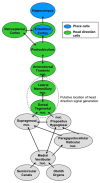The vestibular contribution to the head direction signal and navigation
- PMID: 24795578
- PMCID: PMC4001061
- DOI: 10.3389/fnint.2014.00032
The vestibular contribution to the head direction signal and navigation
Abstract
Spatial learning and navigation depend on neural representations of location and direction within the environment. These representations, encoded by place cells and head direction (HD) cells, respectively, are dominantly controlled by visual cues, but require input from the vestibular system. Vestibular signals play an important role in forming spatial representations in both visual and non-visual environments, but the details of this vestibular contribution are not fully understood. Here, we review the role of the vestibular system in generating various spatial signals in rodents, focusing primarily on HD cells. We also examine the vestibular system's role in navigation and the possible pathways by which vestibular information is conveyed to higher navigation centers.
Keywords: navigation; otolith organs; semicircular canals; spatial orientation; vestibular.
Figures


References
Publication types
Grants and funding
LinkOut - more resources
Full Text Sources
Other Literature Sources

